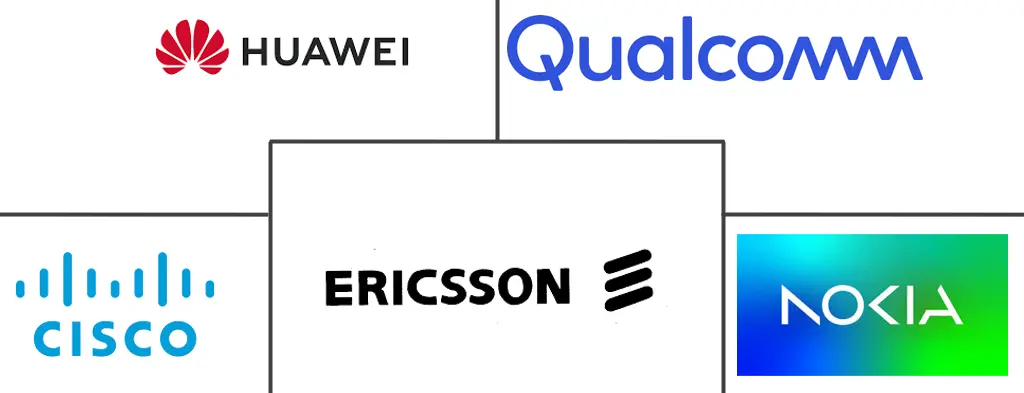Small Cell 5G Network Market Size and Share
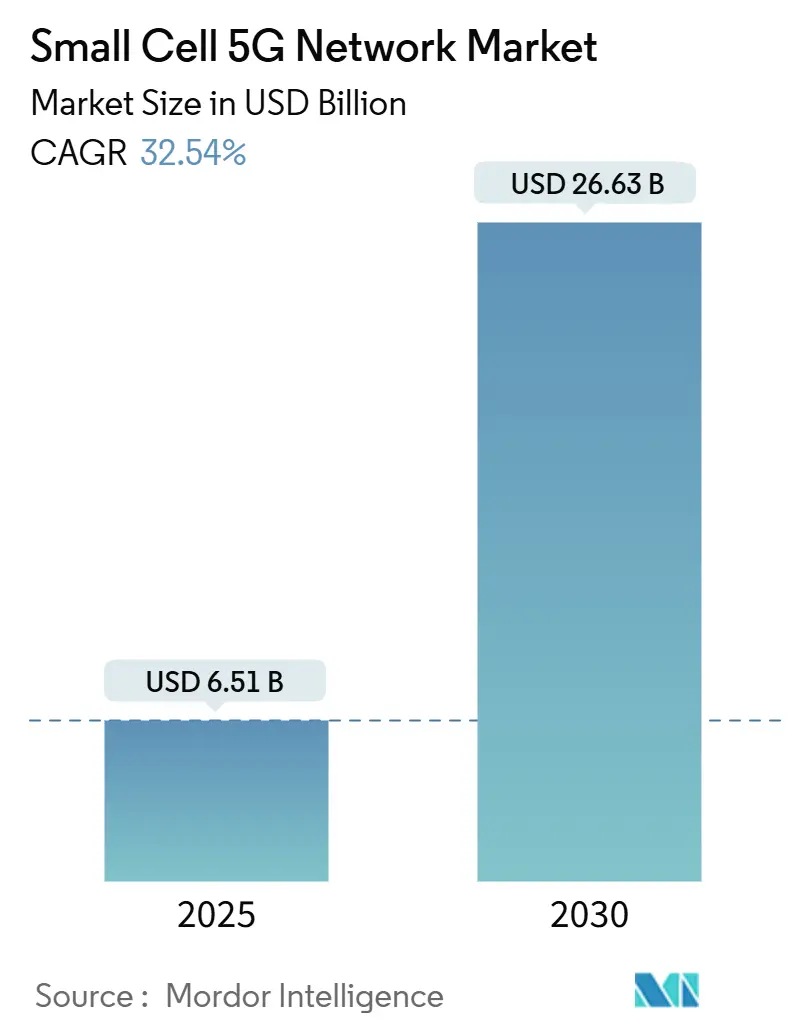
Small Cell 5G Network Market Analysis by Mordor Intelligence
The Small Cell 5G Network Market size is estimated at USD 6.51 billion in 2025, and is expected to reach USD 26.63 billion by 2030, at a CAGR of 32.54% during the forecast period (2025-2030).
Ongoing densification in urban corridors, enterprise digitalization, and the roll-out of AI-native network management systems are accelerating uptake across telecom operators and private-network deployments. Picocells, neutral-host models, and Release-17 NR-U capabilities are expanding addressable use cases by easing spectrum and site constraints. Asia Pacific commands attention through infrastructure scale, yet North America converts infrastructure into premium revenue more efficiently, while Europe’s regulatory clarity promises a delayed but sizable second wave of growth. Competitive dynamics feature established radio vendors pivoting toward software-defined architectures even as AI-enabled chipmakers and Open RAN specialists carve out niches.
Key Report Takeaways
- By cell type, picocells led with a 41% revenue share of the Small Cell 5G Network market in 2024, while mmWave picocells are projected to post the fastest 36.51% CAGR through 2030.
- By operating environment, indoor systems accounted for 63% of the Small Cell 5G Network market share in 2024; outdoor deployments are forecast to rise at a 33.01% CAGR through 2030.
- By frequency band, sub-6 GHz held 74% of the Small Cell 5G Network market size in 2024; mmWave solutions are expanding at a 37% CAGR to 2030.
- By end user, telecom operators retained 56% of 2024 revenue, yet enterprise private networks are advancing at a 32.98% CAGR across the forecast window.
- Asia Pacific captured 38% of global revenue in 2024; North America achieved the highest monetization per site, supported by a USD 14 billion contract between AT&T and Ericsson.
Global Small Cell 5G Network Market Trends and Insights
Drivers Impact Analysis
| Driver | Impact on CAGR Forecast (~%) | Geographic Relevance | Impact Timeline |
|---|---|---|---|
| Rapid densification needs in urban 5G rollouts | +8.20% | Global, concentrated in Asia Pacific and North America | Medium term (2–4 years) |
| Enterprise private network demand (manufacturing, logistics) | +7.80% | Global, led by China, Germany, the US, manufacturing hubs | Long term (≥ 4 years) |
| Release-17 5G NR-U enabling unlicensed small-cell spectrum | +4.10% | North America and the EU regulatory domains | Short term (≤ 2 years) |
| AI-driven self-optimizing networks cutting OpEx | +5.20% | Global, early adoption in developed markets | Long term (≥ 4 years) |
| Source: Mordor Intelligence | |||
Rapid densification needs in urban 5G rollouts
Operators have confirmed that macro cells alone cannot satisfy 5G service-level agreements in dense cities. EE has activated more than 1,000 small cells across the United Kingdom, with 25 London sites moving 7.5 TB of data each week, easing congestion in traditional sectors. Virgin Media O2 introduced the first UK 5G standalone small cells, unlocking network slicing and lower latency that macro sites cannot match. Fractional frequency reuse within small cells improves spectrum utilization, which is critical as uplink-heavy applications such as AR and industrial IoT become mainstream. Municipalities are cutting red tape, and more than 100 neutral-host installations are now live worldwide. Combined, these factors reinforce the densification imperative over the medium term.
Enterprise private-network demand (manufacturing, logistics)
Government policy and Industry 4.0 roadmaps are pushing factories and logistics sites toward deterministic wireless connectivity. China already hosts roughly 4,000 5G factory networks and targets 10,000 by 2027. Nokia counted 850 private 5G customers by Q4 2024, adding 55 in a single quarter. Operational outcomes are compelling: a Thai appliance plant reported 15-20% productivity gains after 5G-enabled automation. Seven European states now license the 26 GHz band locally, and six allocate 100 MHz in the 3.4-3.8 GHz range, making spectrum procurement easier for enterprises. Small cells remain the preferred radio layer because they enforce tight coverage boundaries, integrate edge compute, and support concurrent network slices.
Release-17 5G NR-U enabling unlicensed small-cell spectrum
The new specification lets 5G radios operate in 5 GHz and 6 GHz bands, cutting spectrum costs that once dominated the total cost of ownership. The United States allowed very-low-power use across the entire 6 GHz band in December 2024, while Brazil approved 6425-7125 MHz for IMT in January 2025. Listen-before-talk protocols coexist with Wi-Fi and guarantee service quality for mission-critical users. Removing licensing fees accelerates rollout timelines, giving neutral hosts a viable business case in indoor venues and public hot spots.
AI-driven self-optimizing networks cutting OpEx
Deutsche Telekom has demonstrated AI-assisted planning that cuts manual tasks while lifting key performance indicators. Samsung’s Energy Saving Manager dynamically adapts power levels, lowering energy consumption in live networks. Machine learning also predicts component failures and orchestrates interference mitigation between adjacent cells. As algorithms train on localized traffic patterns, performance and savings compound without fresh capital expenditure.
Restraints Impact Analysis
| Restraint | Impact on CAGR Forecast (~%) | Geographic Relevance | Impact Timeline |
|---|---|---|---|
| Challenging fiber/backhaul economics in suburban & rural zones | –6.8% | Global, acute in rural North America, and developing markets | Long term (≥ 4 years) |
| Persistent security concerns around Open RAN small cells | –3.1% | Enterprise segments, globally, government networks | Medium term (2–4 years) |
| Source: Mordor Intelligence | |||
Challenging fiber/backhaul economics in suburban and rural zones
Aerial fiber construction costs between USD 60,000 and USD 170,000 per mile in suburbs, depressing returns where population density is low. Crown Castle shelved 7,000 U.S. small-cell sites, preserving USD 800 million in future capital spending, after recognizing unfavorable backhaul math. Microwave and satellite backhaul trim capex but cannot yet meet 5G capacity or latency targets. Federal Highway Administration data show that using micro-trenching still leaves a six-to-eight-year breakeven in suburban settings[3]Federal Highway Administration, “Fiber Deployment Cost Quick Reference,” ops.fhwa.dot.gov. Consequently, operators hesitate to densify beyond profitable metros until next-generation wireless backhaul proves commercially viable.
Persistent security concerns around Open RAN small cells
Academic audits have documented over 100 vulnerabilities in LTE and 5G, many linked to open interfaces that broaden the attack surface. The O-RAN Alliance is standardizing threat models and test specifications, yet multi-vendor integration remains complex. Researchers have demonstrated KPI poisoning that cripples near real-time control loops, and adversarial AI attacks can slash network throughput. Enterprises and public agencies demand more thorough supply-chain assurance before adopting Open RAN-based small cells at scale, slowing uptake in security-sensitive verticals.
Segment Analysis
By Cell Type: Picocells Lead Dense Urban Deployments
Picocells contributed 41% of 2024 revenue, confirming their suitability for 100-200 m coverage zones in crowded downtown corridors. The Small Cell 5G Network market size for picocells is on course to expand sharply as mid-band spectrum and multi-user MIMO raise per-site capacity. mmWave picocells show the sharpest 36.51% CAGR, propelled by private networks and fixed wireless access that exploit 28 GHz and 39 GHz to deliver multi-gigabit throughput. Silicon innovation, such as EdgeQ’s base-station-on-a-chip, brings integrated AI that shrinks power, cost, and footprint.
Femtocells hold niche residential and small-office positions but face pressure from Wi-Fi 7, while microcells support wider suburban blocks where picocell density is cost-prohibitive. ORAN-compliant micro-radio units from Comba Telecom reflect a drift toward standardized multi-vendor ecosystems. As AI-enabled optimization narrows performance gaps between form factors, operators gain flexibility to match each site’s capacity requirements without sacrificing operating efficiency.
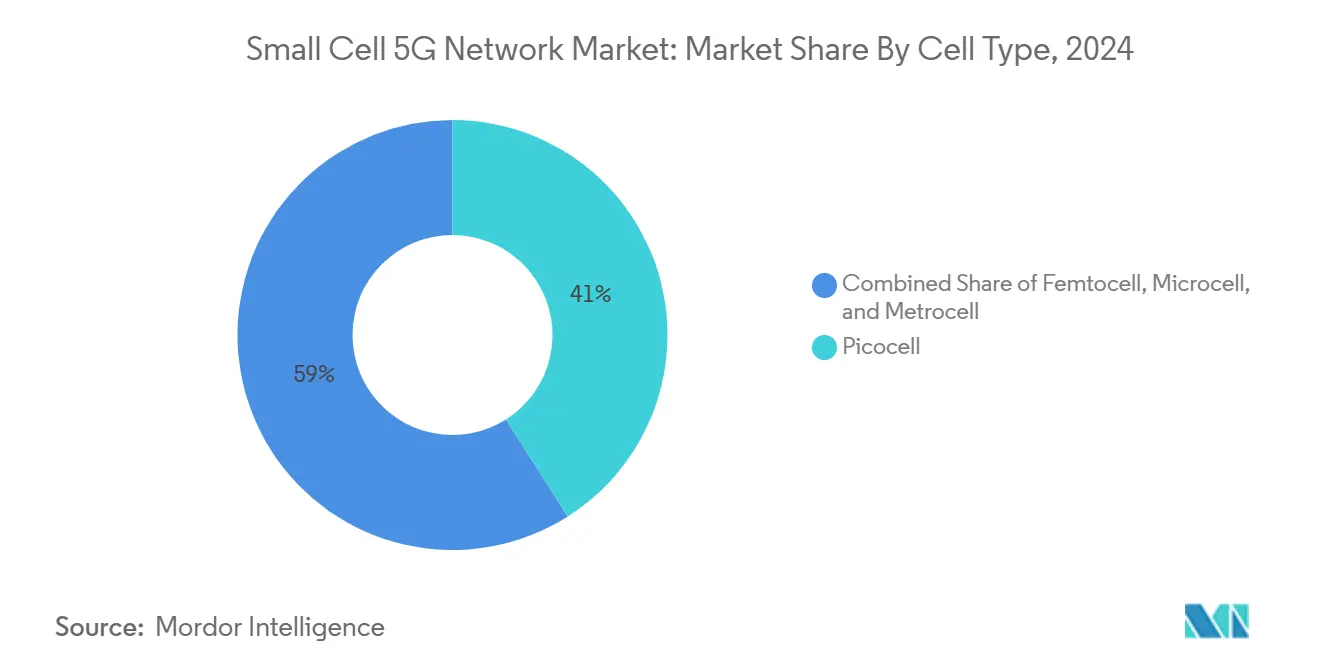
Note: Segment shares of all individual segments available upon report purchase
By Operating Environment: Indoor Dominance Faces Outdoor Growth Surge
Indoor sites represented 63% of 2024 deployments, since mid-band 5G signals fade through modern building materials. Neutral-host systems and smart-building management keep indoor investments compelling for enterprises seeking quality-of-service across offices, stadiums, and factories. The outdoor category is accelerating at a 33.01% CAGR as faster municipal permitting, Release-17 NR-U, and shared infrastructure lower siting friction. Initiatives such as Virgin Media O2’s outdoor cells in central Manchester underline this pivot.
Hybrid solutions are emerging, with Freshwave integrating all four UK carriers into a single outdoor-indoor small cell enclosure, cutting costs by 65% and energy by 60% relative to earlier systems. Indoor providers must now defend against Wi-Fi 7, which advertises 46 Gbps theoretical speeds, by highlighting deterministic latency, security, and slice management that Wi-Fi cannot match.
By Frequency Band: Sub-6 GHz Stability Meets mmWave Innovation
Sub-6 GHz maintained 74% of shipments in 2024, offering the best mix of propagation and capacity for mainstream deployments. Carrier aggregation and dynamic spectrum sharing help operators maximize spectral efficiency while preserving network economics. The mmWave segment is scaling at a 37% CAGR, buoyed by fixed wireless access and high-density enterprise zones. Ericsson, NBN Co, and Qualcomm recently validated 14 km mmWave links delivering gigabit speeds in rural Australia.
Extended-range performance plus AI-guided beam steering has moved mmWave beyond its original line-of-sight stigma. ZTE’s 30 Gbps FWA prototype positions mmWave as a fiber alternative for premium households and factories. Low-band sub-1 GHz retains value for coverage extension but remains a smaller contributor given tight spectrum inventories and modest throughput.
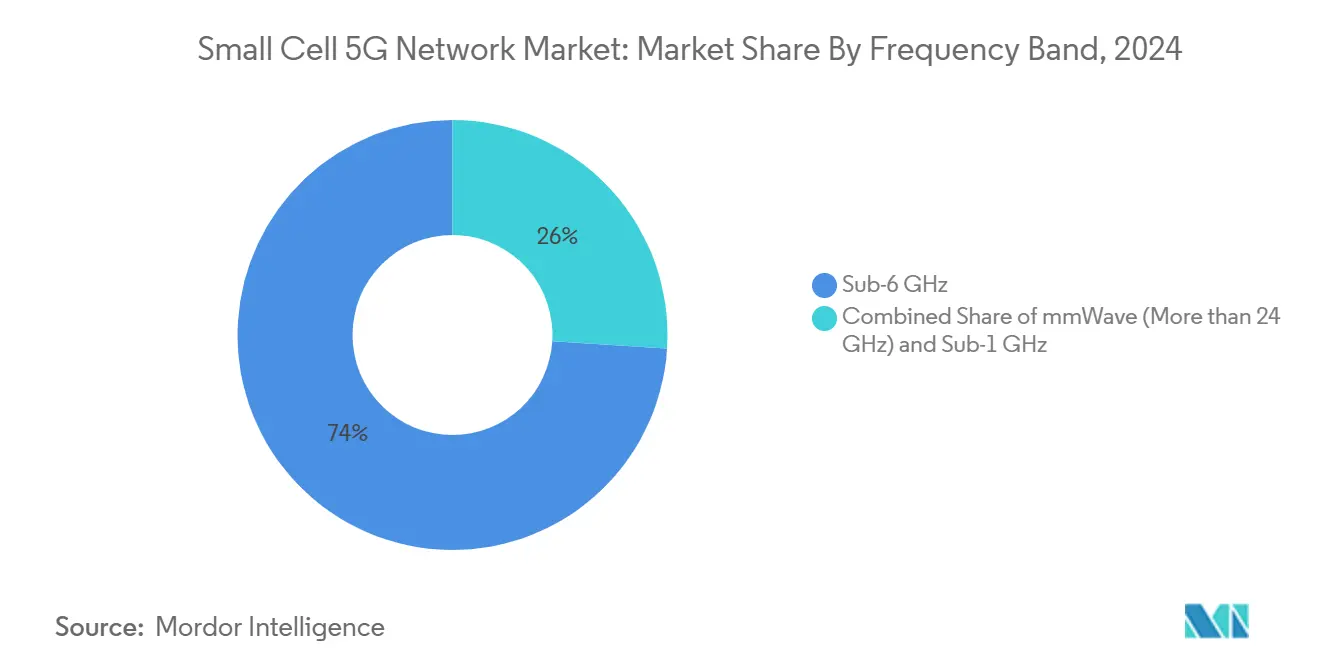
Note: Segment shares of all individual segments available upon report purchase
By End-User: Enterprise Acceleration Challenges Operator Dominance
Telecom operators still supplied 56% of 2024 revenue thanks to licensed spectrum and tower portfolios. Yet enterprise customers posted a 32.98% CAGR, outpacing all other user groups as Industry 4.0 digitization takes hold. The Small Cell 5G Network market size for enterprises is set to climb further as European regulators dedicate 26 GHz and mid-band spectrum to local permits.
Nokia’s tally of 850 private-network customers exemplifies enterprise momentum, while China alone supports 4,000 industrial sites and has set a 10,000-site target by 2027. Residential uptake lags because Wi-Fi remains cost-advantaged, but multi-tenant buildings are piloting neutral-host cells that serve several carriers without new indoor wiring. Emerging MVNO interest in managed private 5G promises another layer of competitive pressure on traditional operators.
Geography Analysis
Asia Pacific owns 38% of 2024 revenue and tracks a 32.60% CAGR to 2030, propelled by China’s 4.4 million 5G base stations and CNY 3 billion earmarked for 5G-Advanced overlays in 300 cities. China Unicom Beijing and Huawei achieved downlink peaks of 11.2 Gbps across a population of 10 million, setting a reference point for future dense overlays[1]Huawei Technologies Co., “China Unicom and Huawei deliver 5G-Advanced in Beijing,” huawei.com. Japan and South Korea push enterprise mmWave, and India’s post-auction build-out supplies scope for densification through public-private partnerships.
North America showcases revenue realization efficiency. Ericsson’s regional revenue climbed 55% year over year on the back of AT&T’s USD 14 billion contract, underlining robust investment returns. More than 50 U.S. neutral-host projects operate in CBRS, and Canada’s TELUS is rolling out the first commercial virtualized Open RAN, positioning the region at the forefront of cloud-native RAN experimentation. Still, Crown Castle’s canceled deployments highlight suburban economics as a persistent hurdle.
Europe enjoys a clear spectrum policy yet lags in standalone 5G coverage, reaching only 2% penetration by late 2024. Virgin Media O2 and EE are ramping small-cell footprints, but many operators wait for a business-case inflection once device penetration rises. In the Middle East, the UAE logged record 30.5 Gbps 5G speeds, and du committed AED 2 billion to hyperscale data centers, signaling that Gulf operators will leapfrog directly to 5G-Advanced. Latin America sees Brazil’s Brisanet and Uruguay’s Antel expanding public 5G, though macroeconomic constraints and spectrum scarcity temper small-cell rollouts.
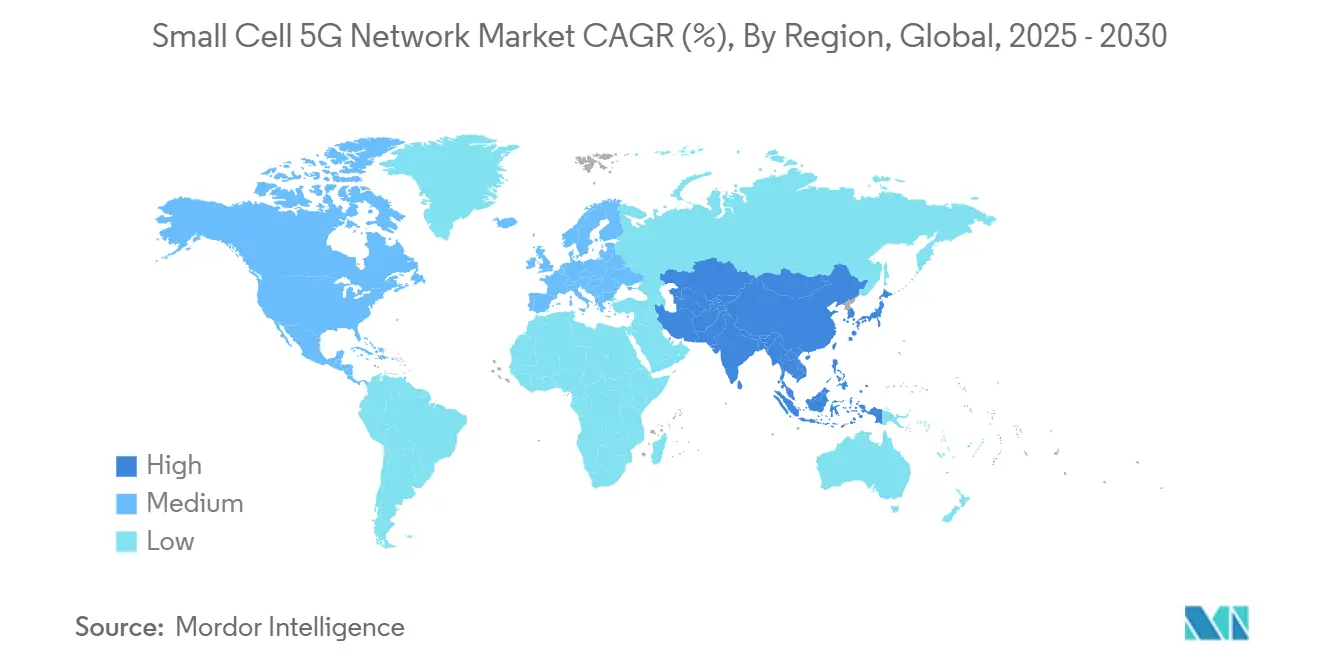
Competitive Landscape
Competition is moderate as long-standing infrastructure vendors wrestle with AI-centric silicon entrants and Open RAN service companies. Ericsson, Nokia, Samsung, and Huawei retain scale advantages but face price pressures from component inflation. EdgeQ raised USD 126 million to commercialize an AI-integrated base-station-on-a-chip, demonstrating investor appetite for disruptors.
Strategically, incumbents pivot to software differentiation. Ericsson partnered with Google Cloud to unveil 5G Core-as-a-Service, giving operators a cloud-native on-ramp that shrinks time-to-market and supports elastic scaling[2]Cloud Google, “Ericsson and Google Cloud unveil 5G Core-as-a-Service,” cloud.google.com. Samsung plans more than 53,000 commercial vRAN sites by 2025 and bundles Energy Saving Manager to reduce OpEx. Patent filings on extended-reality optimization and AI orchestration from Qualcomm, Meta, and Apple indicate a future battleground in user-experience-driven capacity planning.
Neutral-host specialists and private-network integrators carve out growth lanes where legacy vendor commercial models fall short. Shared infrastructure lowers cost barriers for property managers, while managed services offer appeal to enterprises lacking telecom expertise. Supply chain volatility favors bigger vendors that pre-book inventory, yet persistent shortages open doors for second-tier suppliers willing to customize radio modules in exchange for share gains.
Small Cell 5G Network Industry Leaders
-
Qualcomm Technologies Inc.
-
Huawei Technologies Co. Ltd
-
Telefonaktiebolaget LM Ericsson
-
Cisco Systems Inc.
-
Nokia Corporation
- *Disclaimer: Major Players sorted in no particular order
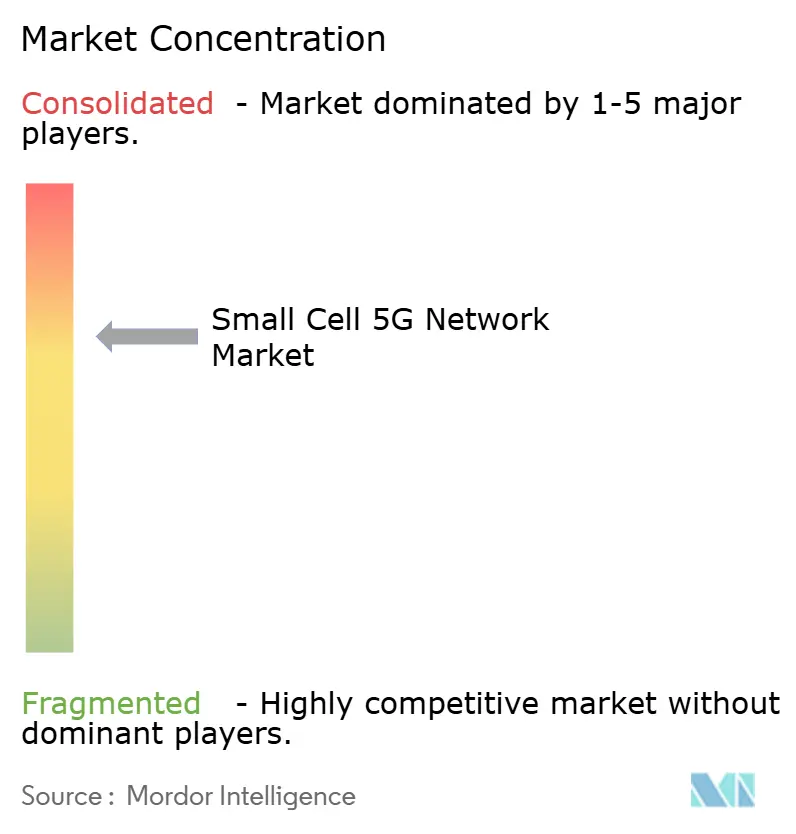
Recent Industry Developments
- June 2025: Ericsson and Google Cloud launched carrier-grade 5G Core-as-a-Service, enabling deployment within minutes and AI-assisted troubleshooting.
- June 2025: Nokia reported breakthrough mmWave performance and strong fixed wireless access growth projections.
- March 2025: RANsemi and ACES partnered on an Open RAN neutral-host small-cell system.
- February 2025: Crown Castle canceled 7,000 small-cell deployments, freeing USD 800 million in capex.
Research Methodology Framework and Report Scope
Market Definitions and Key Coverage
Our study treats the small-cell 5G network market as all purpose-built, low-power base stations, femtocells, picocells, and microcells that transmit 3GPP-compliant 5G NR signals and the tightly linked software licenses, installation, and three-year support fees sold with them. These nodes span indoor venues (offices, malls, factories, arenas) and dense outdoor hot spots where macro gNodeBs alone cannot keep up with data demand.
Scope exclusion: Large macro radio sites, 4G-only small cells, and passive distributed antenna systems are left outside the numerical model.
Segmentation Overview
- By Cell Type
- Femtocell
- Picocell
- Microcell
- Metrocell
- By Operating Environment
- Indoor
- Outdoor
- By Frequency Band
- Sub-6 GHz
- mmWave (More than 24 GHz)
- Sub-1 GHz
- By End-User
- Telecom Operators
- Enterprises
- Residential
- By Geography
- North America
- United States
- Canada
- Mexico
- South America
- Brazil
- Argentina
- Rest of South America
- Europe
- Germany
- United Kingdom
- France
- Russia
- Rest of Europe
- Asia-Pacific
- China
- India
- Japan
- South Korea
- Rest of Asia-Pacific
- Middle East
- Saudi Arabia
- UAE
- Turkey
- Rest of Middle East
- Africa
- South Africa
- Rest of Africa
- North America
Detailed Research Methodology and Data Validation
Primary Research
We interviewed radio-access planners at tier-1 operators across North America, Europe, and Asia-Pacific, neutral-host integrators, and facilities managers rolling out private 5G. Their insights clarified average selling prices, indoor-outdoor deployment ratios, and mmWave upgrade timing, letting us fine-tune volume baselines and stress-test cost curves.
Desk Research
Analysts began with regulator databases such as the FCC tower registry, China's MIIT small-cell counts, and EU 5G Observatory deployment maps, then layered in demand indicators from GSMA Mobile Economy, Ericsson Mobility Report, and peer-reviewed IEEE papers on mid-band propagation. Company 10-Ks, investor decks, and building-code filings enriched cost and adoption assumptions, while paid platforms (D&B Hoovers for vendor revenue splits and Dow Jones Factiva for contract awards) sharpened commercial reality. The sources cited illustrate our desk work; dozens more were screened to cross-check figures and definitions.
Market-Sizing & Forecasting
A top-down model converts regulator-reported 5G site densities and subscriber traffic growth into capacity gaps that small cells must fill. Before bottom-up checks, sampled vendor shipment data and validated ASP ranges are applied to reconcile totals. Key variables include 5G subscriber density per square kilometer, monthly data usage, indoor floor space served, spectrum mix (sub-6 GHz vs mmWave), and operator RAN capex. Multivariate regression links these drivers to historical adoption; scenario analysis then shows the effect of spectrum-auction slippage or slower private-network take-up. Missing shipment data points are bridged using three-year rolling averages from public vendor disclosures.
Data Validation & Update Cycle
Outputs pass variance and anomaly checks against independent yardsticks (for example, fiber backhaul installs and municipal permit volumes). Senior analysts review every assumption, and the model is refreshed annually, with interim updates triggered by material events such as major spectrum awards.
Why Mordor's Small Cell 5G Network Baseline Earns Boardroom Trust
Published estimates often diverge because firms apply dissimilar scopes, pricing paths, and refresh cadences.
Ours stays centered on deployable 5G small cells and the revenue streams they actually generate.
Benchmark comparison
| Market Size | Anonymized source | Primary gap driver |
|---|---|---|
| USD 6.51 bn (2025) | Mordor Intelligence | - |
| USD 5.08 bn (2024) | Global Consultancy A | Bundles IoT-centric mmWave hardware and services; applies aggressive shipment-to-revenue multipliers; slower refresh cadence |
| USD 7.54 bn (2025) | Trade Journal B | Counts small-cell radios embedded in macro upgrades and uses forward-priced ASPs without regional weighting |
| USD 2.41 bn (2025) | Sector Analyst C | Excludes enterprise indoor cells and neutral-host lease income, leading to conservative base |
These contrasts show that, while others skew low or high by widening or narrowing scope, Mordor's disciplined variable selection and yearly review give clients a balanced, transparent foundation they can trace and replicate.
Key Questions Answered in the Report
What is the current value of the Small Cell 5G Network market?
The market is worth USD 6.51 billion in 2025 and is projected to expand at a 32.54% CAGR to USD 26.63 billion by 2030.
Which region leads the Small Cell 5G Network market?
Asia Pacific commands 38% of 2024 revenue, driven by China’s extensive 5G infrastructure and aggressive enterprise adoption.
Why are enterprises investing in private 5G small-cell networks?
Manufacturing and logistics firms need deterministic latency, localized data processing, and spectrum control, which small cells deliver more reliably than macro sites or Wi-Fi.
How important is mmWave to future small-cell growth?
The mmWave segment is forecast to grow at a 37% CAGR as extended-range breakthroughs enable fixed wireless access and high-capacity private networks.
What major restraint could slow small-cell deployment?
High fiber and backhaul costs in suburban and rural areas remain the most significant economic barrier, particularly in North America and emerging markets.
How are vendors differentiating their small-cell offerings?
Incumbents focus on software-defined and AI-optimized solutions, while new entrants target cost and integration advantages through Open RAN-compatible chipsets and neutral-host models.
Page last updated on:
